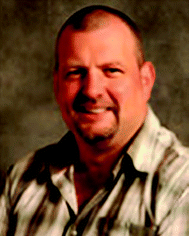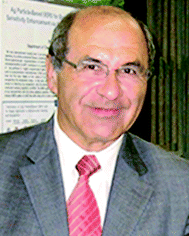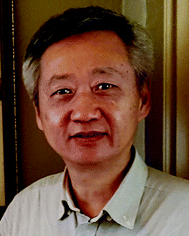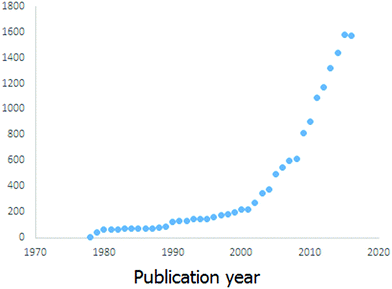SERS – facts, figures and the future
Duncan
Graham
 a,
Martin
Moskovits
a,
Martin
Moskovits
 b and
Zhong-Qun
Tian
b and
Zhong-Qun
Tian
 c
c
aDepartment of Pure and Applied Chemistry Technology and Innovation Centre, University of Strathclyde, 99 George Street, Glasgow, G1 1RD, UK
bDepartment of Chemistry and Biochemistry, University of California, Santa Barbara, CA 93106, USA
cState Key Lab. of Physical Chemistry of Solid Surfaces, Xiamen University, Xiamen, 361005, China
Surface-enhanced Raman spectroscopy (SERS) is over 40 years old. The first SERS spectrum was reported in 1974,1 and its extraordinary enhancement was first estimated in 1977.2 Its foundation as a primarily plasmonic effect was more or less fully established by the mid 1980s, with many of the foundational aspects of its origin, greatly enhanced electromagnetic fields in the vicinity of judiciously illuminated nanostructured metals, and especially at SERS hot spots, often nano-sized clefts and interstices, fully established before 1990. The mid-1990s produced a renaissance in SERS by reports of high quality SERS spectra obtained from single molecules.3 SERS also obtained a boost in the 1990s from the strong international interest in nanoscience and nanotechnology. Also helpful were the significant improvements in Raman spectrometers and the lasers they used, reducing their cost, complexity and size.
It is also likely correct to state that our current interest in plasmonics, the physics and chemistry of plasmonic materials and in metamaterials with their extraordinary photonic properties, arose to a significant extent out of the broad international interest in SERS. It is not a coincidence that the chief early protagonists of plasmonics and metamaterials had also had leading roles in SERS. All-told, it is, therefore, little wonder that the number of publications related to SERS has never declined; indeed, it sharply increased from 2003 to the present.
A simple Web of Science search for articles on ‘surface enhanced Raman’ reveals that 15![[thin space (1/6-em)]](https://www.rsc.org/images/entities/char_2009.gif) 857 SERS papers have been published since 1974. Fig. 1 shows the increase in the number of SERS papers to the present. The total number of authors publishing in the field has surprisingly remained approximately constant at 156 since 2007 when we first published a themed issue on SERS for Chemical Society Reviews, compared to 159 authors in 2016, the full year before this themed edition will appear. However, the 597 papers published in 2007 contrast notably to the over 1500 papers that appeared in 2016, indicating that although the number of SERS authors has remained approximately constant over the last decade, productivity has more than doubled. Many scientists from around the globe are involved in SERS, which, notably, has now expanded into disciplines beyond the traditional physical chemistry and physics fields in which many of the SERS pioneers, and much of the fundamental work produced in the early stages of the development of SERS, belonged.
857 SERS papers have been published since 1974. Fig. 1 shows the increase in the number of SERS papers to the present. The total number of authors publishing in the field has surprisingly remained approximately constant at 156 since 2007 when we first published a themed issue on SERS for Chemical Society Reviews, compared to 159 authors in 2016, the full year before this themed edition will appear. However, the 597 papers published in 2007 contrast notably to the over 1500 papers that appeared in 2016, indicating that although the number of SERS authors has remained approximately constant over the last decade, productivity has more than doubled. Many scientists from around the globe are involved in SERS, which, notably, has now expanded into disciplines beyond the traditional physical chemistry and physics fields in which many of the SERS pioneers, and much of the fundamental work produced in the early stages of the development of SERS, belonged.
For this themed edition we invited groups of authors to work together so that at least some of the articles represent a consensus position of several, rather than individual, laboratories. The final product is a mixture of individual contributions and collective efforts from world renowned experts in the field. One only needs to browse the list of authors and the titles of their articles in this themed edition to instantly see both the high quality and the diversity of the topics covered in depth in this collection. We have papers discussing the theory of SERS, pushing the resolution of SERS using tip enhancement, and reporting new nanomaterials which show exquisite control over morphology and surface chemistry, as well as reviews on applications of SERS in biological and biomedical sciences and plasmon enhanced spectroscopy going beyond Raman scattering into fluorescence and the use of quantum optics. We feel this gives a very strong indication of the current forefront of research in the field of SERS with each review providing a unique and insightful look into the future for SERS. The combination of individuals with groups writing collectively on a single topic has produced a collection of highly accessible and engaging articles that we believe will be of significant value and interest not just to the SERS community but to the scientific community in general who are interested in high quality research.
We hope you enjoy reading these articles and who knows what will happen by 2027!
Notes and references
- M. Fleischmann, P. J. Hendra and A. J. McQuillan, Raman spectra of pyridine adsorbed at a silver electrode, Chem. Phys. Lett., 1974, 26, 163–166 CrossRef CAS.
- D. L. Jeanmaire and R. P. Van Duyne, Surface Raman spectroelectrochemistry. 1. Heterocyclic, aromatic, and aliphatic amines adsorbed on anodized silver electrode, J. Electroanal. Chem., 1977, 84, 1–20 CrossRef CAS.
- S. Nie and S. R. Emory, Probing single molecules and single nanoparticles by surface-enhanced Raman scattering, Science, 1997, 275, 1102–1106 CrossRef CAS PubMed.
| This journal is © The Royal Society of Chemistry 2017 |




